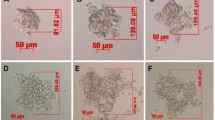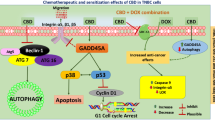Abstract
Most breast cancers originate in the lobules or ducts of the breast. Breast cancer as the second main cause of death among women in the world is the most common kind of cancer in women. Studies have been conducted to find the optimal treatment for breast cancer. Moreover, the therapeutic effects of different drugs and substances on this disease have been intensively researched. Boric acid accounts for 96% of the boron content in body fluids, and its derivatives are absorbed by the human body. It is assumed to be represented as (B(OH)2). Experimental studies have shown a reduction of cell proliferation and stimulation of apoptosis in some melanoma, prostate, and colon cancer cell lines through boric acid. The aim of this study was to investigate if boric acid could be used for treating breast cancer. The impacts of boric acid on the human breast carcinoma cell lines MCF-7 and MDA-MB-231 were studied with TUNEL, BrdU, caspase-3, and endo-G immunohistochemical studies in 3D and 2D culture systems. Furthermore, we conducted a qRT-PCR study to show changes in the expression of some genes involved in apoptosis. Suppression of cell proliferation through boric acid–inducing apoptosis was observed both in 3D and 2D culture conditions. These results are compatible with the gene expression results. The ENDOG, CASP3, CASP8, and CASP9 gene expression significantly changed at all time intervals in MCF-7 and MD-MB-231 cell lines boric acid can potentially treat breast cancer as an anti-cancer agent candidate.













Similar content being viewed by others
Data Availability
Our study is a cell culture study. Cell lines used in the study DSMZ-German Collection of Microorganisms and Cell Cultures GmbH was provided. In accordance with German law (Biostoffverordnung), the DSMZ has carried out biological risk assessments for every cell line in the collection. Due to the nature of the research, due to [ethical/legal/commercial] supporting data is not available.
References
Terlikowska K, Witkowska A, Terlikowski S (2014) Curcumin in chemoprevention of breast cancer. Postepy Hig Med Dosw 68:571–578. https://doi.org/10.5604/17322693.1102294
Kahraman E, Göker E (2023) Boric Acid Treatment Strengthens the Cytotoxic Effect of Sorafenib on Triple Negative Breast Cancer Cell Lines. Celal Bayar University J Sci 19(2):137–141
Burstein HJ, Curigliano G, Thurlimann B, Weber WP, Poortmans P, Regan MM et al (2021) Customizing local and systemic therapies for women with early breast cancer: the St. Gallen International Consensus Guidelines for treatment of early breast cancer 2021. Ann Oncol 32(10):1216–1235. https://doi.org/10.1016/j.annonc.2021.06.023
Murphy N, McCarthy E, Dwyer R, Farras P (2021) Boron clusters as breast cancer therapeutics. J Inorg Biochem 218:111412. https://doi.org/10.1016/j.jinorgbio.2021.111412
Dzubak P, Hajduch M, Vydra D, Hustova A, Kvasnica M, Biedermann D et al (2006) Pharmacological activities of natural triterpenoids and their therapeutic implications. Nat Prod Rep 23(3):394–411. https://doi.org/10.1039/b515312n
Cragg GM, Newman DJ (2009) Nature: a vital source of leads for anticancer drug development. Phytochem Rev 8(2):313–331. https://doi.org/10.1007/s11101-009-9123-y
Akram M, Iqbal M, Daniyal M, Khan AU (2017) Awareness and current knowledge of breast cancer. Biol Res 50(1):33. https://doi.org/10.1186/s40659-017-0140-9
Arpino G, Bardou VJ, Clark GM, Elledge RM (2004) Infiltrating lobular carcinoma of the breast: tumor characteristics and clinical outcome. Breast Cancer Res 6(3):R149–R156. https://doi.org/10.1186/bcr767
Sezekler I, Ersoz M, Turan MA, Coskun ZM (2020) Investigation of the biochemical and apoptotic changes in breast cancer cells treated with leaf extract from tea (Camellia sinensis L.) grown with added boric acid. Pak J Pharm Sci 33(5):1927–1932
Scaria B, Sood S, Raad C, Khanafer J, Jayachandiran R, Pupulin A et al (2020) Natural Health Products (NHP's) and natural compounds as therapeutic agents for the treatment of cancer; mechanisms of anti-cancer activity of natural compounds and overall trends. Int J Mol Sci 21(22). https://doi.org/10.3390/ijms21228480
Sevimli M, Bayram D, Ozgocmen M, Armagan I, Sevimli TS (2022) Boric acid suppresses cell proliferation by TNF signaling pathway mediated apoptosis in SW-480 human colon cancer line. J Trace Elem Med Biol 71. https://doi.org/10.1016/j.jtemb.2022.126958
Wang Y, Zhao Y, Chen X (2008) Experimental study on the estrogen-like effect of boric Acid. Biol Trace Elem Res 121(2):160–170. https://doi.org/10.1007/s12011-007-8041-3
Barranco WT, Hudak PF, Eckhert CD (2007) Evaluation of ecological and in vitro effects of boron on prostate cancer risk (United States). Cancer Causes Control 18(1):71–77. https://doi.org/10.1007/s10552-006-0077-8
Yilmaz S, Ustundag A, Ulker OC, Duydu Y (2016) Protective Effect of Boric Acid on Oxidative DNA Damage In Chinese Hamster Lung Fibroblast V79 Cell Lines. Cell J 17(4):748–754
Mohammed EE, Turkel N, Yigit UM, Dalan AB, Sahin F (2023) Boron derivatives inhibit the proliferation of breast cancer cells and affect tumor-specific T cell activity in vitro by distinct mechanisms. Biol Trace Elem Res. https://doi.org/10.1007/s12011-023-03632-0
Bradke TM, Hall C, Carper SW, Plopper GE (2008) Phenylboronic acid selectively inhibits human prostate and breast cancer cell migration and decreases viability. Cell Adh Migr 2(3):153–160. https://doi.org/10.4161/cam.2.3.6484
Cui Y, Winton MI, Zhang ZF, Rainey C, Marshall J, De Kernion JB et al (2004) Dietary boron intake and prostate cancer risk. Oncol Rep 11(4):887–892
Korkmaz M, Uzgoren E, Bakirdere S, Aydin F, Ataman OY (2007) Effects of dietary boron on cervical cytopathology and on micronucleus frequency in exfoliated buccal cells. Environ Toxicol 22(1):17–25. https://doi.org/10.1002/tox.20229
Mahabir S, Spitz MR, Barrera SL, Dong YQ, Eastham C, Forman MR (2008) Dietary boron and hormone replacement therapy as risk factors for lung cancer in women. Am J Epidemiol 167(9):1070–1080. https://doi.org/10.1093/aje/kwn021
Bayram D, Armagan I, Ozgocmen M, Senol N, Calapoglu M (2018) Determination of apoptotic effect of juglone on human bladder cancer TCC-SUP and RT-4 Cells: an in vitro study. J Environ Pathol Toxicol Oncol 37(2):173–181. https://doi.org/10.1615/JEnvironPatholToxicolOncol.2018025226
Fedchenko N, Reifenrath J (2014) Different approaches for interpretation and reporting of immunohistochemistry analysis results in the bone tissue - a review. Diagn Pathol :9. https://doi.org/10.1186/s13000-014-0221-9
Celik DA, Gurbuz N, Togay VA, Ozcelik N (2020) Ochratoxin A causes cell cycle arrest in G1 and G1/S phases through p53 in HK-2 cells. Toxicon 180:11–17. https://doi.org/10.1016/j.toxicon.2020.03.012
Ozgocmen M, Bayram D, Yavuz Turel G, Togay VA, Sahin CN (2021) Secoisolariciresinol diglucoside induces caspase-3-mediated apoptosis in monolayer and spheroid cultures of human colon carcinoma cells. J Food Biochem 45(5):e13719. https://doi.org/10.1111/jfbc.13719
Ahmad N, Ammar A, Storr SJ, Green AR, Rakha E, Ellis IO et al (2018) IL-6 and IL-10 are associated with good prognosis in early stage invasive breast cancer patients. Cancer Immunol Immunother 67(4):537–549. https://doi.org/10.1007/s00262-017-2106-8
Nielsen FH (2014) Update on human health effects of boron. J Trace Elem Med Biol 28(4):383–387. https://doi.org/10.1016/j.jtemb.2014.06.023
Hacioglu C, Kar F, Kacar S, Sahinturk V, Kanbak G (2020) High concentrations of boric acid trigger concentration-dependent oxidative stress, apoptotic pathways and morphological alterations in DU-145 human prostate cancer cell line. Biol Trace Elem Res 193(2):400–409. https://doi.org/10.1007/s12011-019-01739-x
Simsek F, Inan S, Korkmaz M (2019) An in vitro study in which new boron derivatives maybe an option for breast cancer treatment. EJMO 3(1):22–27. https://doi.org/10.14744/ejmo.2018.0020
Fırat F, Aladağ T (2022) Comparative Effects of Boric Acid and Resveratrol on MCF-7 Breast Cancer Cells Metastatic Behaviour. Int J Res-GRANTHAALAYAH 10(1):34–46. https://doi.org/10.29121/Granthaalayah.V10.İ1.2022.4460
Eroz M (2021) Antioxidant and Anti-cancer Activity of Boric Acid in 8305C Anaplastic Thyroid Cancer Cells. Gümüşhane University J Health Sci 10(2):213–221. https://doi.org/10.37989/gumussagbil.834614
Acerbo AS, Miller LM (2009) Assessment of the chemical changes induced in human melanoma cells by boric acid treatment using infrared imaging. Analyst 134(8):1669–1674. https://doi.org/10.1039/b823234b
Evan GI, Vousden KH (2001) Proliferation, cell cycle and apoptosis in cancer. Nature 411(6835):342–348. https://doi.org/10.1038/35077213
Bologna-Molina R, Mosqueda-Taylor A, Molina-Frechero N, Mori-Estevez AD, Sanchez-Acuna G (2013) Comparison of the value of PCNA and Ki-67 as markers of cell proliferation in ameloblastic tumors. Med Oral Patol Oral 18(2):E174–E1E9
Kyrylkova K, Kyryachenko S, Leid M, Kioussi C (2012) Detection of apoptosis by TUNEL assay. Methods Mol Biol 887:41–47. https://doi.org/10.1007/978-1-61779-860-3_5
Scorei RI, Popa R (2010) Boron-containing compounds as preventive and chemotherapeutic agents for cancer. Anti-Cancer Agent Me 10(4):346–351
Degterev A, Boyce M, Yuan JY (2003) A decade of caspases. Oncogene 22(53):8543–8567. https://doi.org/10.1038/sj.onc.1207107
Fulda S, Debatin KM (2006) Extrinsic versus intrinsic apoptosis pathways in anticancer chemotherapy. Oncogene 25(34):4798–4811. https://doi.org/10.1038/sj.onc.1209608
Saelens X, Festjens N, Vande Walle L, van Gurp M, van Loo G, Vandenabeele P (2004) Toxic proteins released from mitochondria in cell death. Oncogene 23(16):2861–2874. https://doi.org/10.1038/sj.onc.1207523
Scorei R, Ciubar R, Ciofrangeanu CM, Mitran V, Cimpean A, Iordachescu D (2008) Comparative effects of boric acid and calcium fructoborate on breast cancer cells. Biol Trace Elem Res 122(3):197–205. https://doi.org/10.1007/s12011-007-8081-8
Carper SW, Hall C, Adebayo J, Vo V, Meacham SL (2006) Boric acid induces apoptosis in the prostate cancer cell line DU-145 via a caspase 3 dependent mechanism. FASEB J 20(4):A194-A
Author information
Authors and Affiliations
Contributions
Dilek Bayram was responsible for designing the Project, funding acquisition; and writing the manuscript. Dilek Bayram, Meltem Özgöçmen, Dilek Aşçı Çelik, and Emine Sarman were responsible for laboratory analyses. Dilek Bayram and Murat Sevimli made critical revisions to the manuscript. In addition; the English writing language was edited by Scribendi.
Corresponding author
Ethics declarations
Ethical Approval
Not applicable.
Competing Interests
The authors declare no competing interests.
Additional information
Publisher’s Note
Springer Nature remains neutral with regard to jurisdictional claims in published maps and institutional affiliations.
Rights and permissions
Springer Nature or its licensor (e.g. a society or other partner) holds exclusive rights to this article under a publishing agreement with the author(s) or other rightsholder(s); author self-archiving of the accepted manuscript version of this article is solely governed by the terms of such publishing agreement and applicable law.
About this article
Cite this article
Bayram, D., Özgöçmen, M., Çelik, D.A. et al. Does Boric Acid Inhibit Cell Proliferation on MCF-7 and MDA-MB-231 Cells in Monolayer and Spheroid Cultures by Using Apoptosis Pathways?. Biol Trace Elem Res 202, 2008–2021 (2024). https://doi.org/10.1007/s12011-023-03810-0
Received:
Accepted:
Published:
Issue Date:
DOI: https://doi.org/10.1007/s12011-023-03810-0




